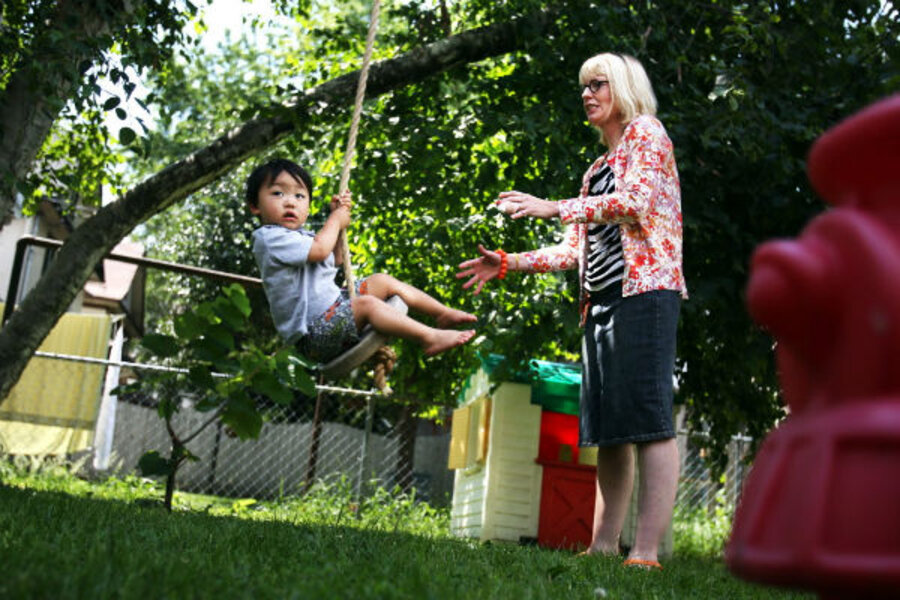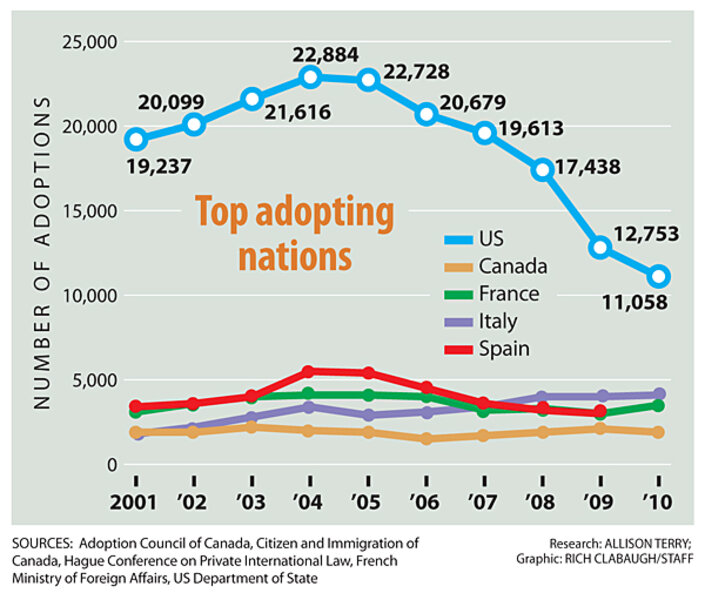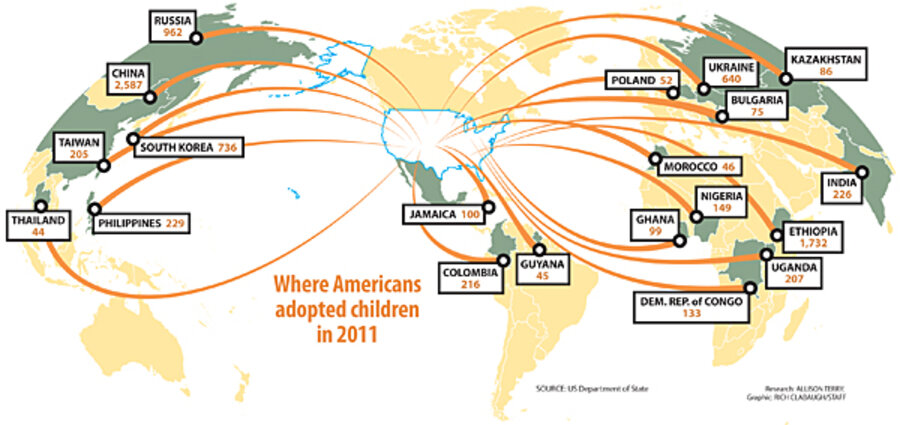Adoption: Minnesota reflects trend in plummeting adoption rates
Loading...
| ST. PAUL, Minn.
Minnesota leads the country in the number of international adoptions per capita, but tighter regulations have caused those numbers to drop sharply in recent years.
That's left families adrift and forced one of the state's oldest agencies to scale back on the number of adoptions it arranges.
The number of foreign children adopted by Americans has plummeted from 22,991 in 2004 to 9,319 in 2011, according to US State Department statistics (see accompanying chart for top adopting nations). Minnesota has experienced a similar decline. In 2005, the state reported 923 international adoptions. The number has fallen every year since then, reaching a low of 355 adoptions last year.
The sudden drop has led to financial problems for one of the country's oldest and largest adoption agencies, St. Paul-based Children's Home Society and Family Services, Minnesota Public Radio reports.
Faced with long waiting lists and high overhead costs, the nonprofit agency has been unable to bring in enough money from adoption fees to cover expenses. It recorded year-end deficits of more than $2 million for each of the past three fiscal years.
Lutheran Social Service has begun managing the agency's adoptions as part of a three-year renewable contract to help the adoption agency cope with the slowdown. Children's Home Society executive Maureen Warren said she expects her 123-year-old organization will learn to recover financially and that the adoption industry will rebound.
"We really think that this is a reset and that some of the change is very welcome, even though it has put us in some financial stress," Ms. Warren said.
The changes have also led to long waits for adoptive parents, including Jean Thilmany of St. Paul, who these days keeps a close eye on 22-month-old Frankie as he runs around the family's home, blowing bubbles and playing with the family dog.
Frankie was born in South Korea. The story of how he came to live 6,000 miles away in Minnesota is, like many recent stories of international adoption, full of unforeseen complications and delays. For Mrs. Thilmany and her husband Dan, a nine-month-wait for a baby turned into four years.
"The waiting process was horrible," she said. "It was something I could never in a million years go through again. It was wrenching because it's out of your control, and every time you reached a milestone and thought you had made it, it was plucked from you and moved further out, and you don't know who to blame."
After a difficult birth of the couple's first child, Alvin, Jean Thilmany's doctor advised against another pregnancy. The couple wanted another child, so they decided to adopt from Ethiopia, where the number of international adoptions had increased from 42 in 2009 to more than 1,700 in 2008 (see accompanying chart for where Americans adopted children in 2011). They spent more than $20,000 on adoption fees and related expenses. Thilmany said they decided against domestic adoption because the selection process seemed too personal.
"We were insecure and felt a birth mom wouldn't choose us," she said.
While the couple waited, Ethiopia's adoption process came under scrutiny. In some cases, adoption officials had matched children with potential families before the birth parents had formally relinquished custody, according to the U.S. State Department. The confusion created bureaucratic problems and raised concerns of among adoption agencies and the Ethiopian government of possible unethical practices.
In response, Ethiopia slowed the process and allowed just five adoptions per day, instead of the usual 50 or so cases. The slowdown gave the government more time to investigate each case, but it also meant much longer waits for children and adoptive parents.
In St. Paul, the Thilmanys changed course and decided to adopt from South Korea. The couple traveled to Seoul to pick up Frankie in April.
Jean Thilmany said her family now feels complete.
"It's been wonderful," she said, as Frankie laughed and batted around a plastic sword. "It's been exactly what we thought it would be, but even better."
The family's experience is not unique.
International adoption has become more complicated since more countries added regulations to make the process more transparent and crack down on child trafficking. Some countries like Guatemala and Cambodia have even temporarily halted adoptions to the United States.
More than 80 countries have signed the Hague Adoption Convention, an international agreement to create universal adoption practices. The United States began enforcing the agreement in 2008.
Other countries with fast-growing economies, like China, are increasingly urging their own citizens to adopt. In some cases, it's a matter of national pride, said Lutheran Social Service CEO Jodi Harpstead.
"There's a general sense that on the world stage, when a country is doing a lot of adoption out of its country, that it's not taking care of its own children," Ms. Harpstead said. "And I think there's a sense of embarrassment about that."
Meanwhile, some couples seeking to adopt overseas are pursuing other options. It's much easier in most countries to adopt a child with special needs.
That's how David and Avisia McKoskey, of St. Louis Park, Minn., adopted their son, Henry, from southern China in 2007. Born with a cleft lip and palate, Henry, now 6, was found in a basket left on the steps of a temple.
"It just brought us to tears just to think about it," David McKoskey said.
Chinese officials tried to find a Chinese family willing to adopt the child but were unsuccessful. Mr. McKoskey said he was reassured by the amount of paperwork the process required. He wanted to make sure that Henry was abandoned and not the victim of child trafficking or other unethical practices.
"To hear that children have been bought and sold on whatever market ... to reduce that to zero is a worthy goal," he said. "It's I think a worthier goal than making me fill out a few more papers."
The couple plans to travel to China again later this month to adopt a baby girl with special needs.







